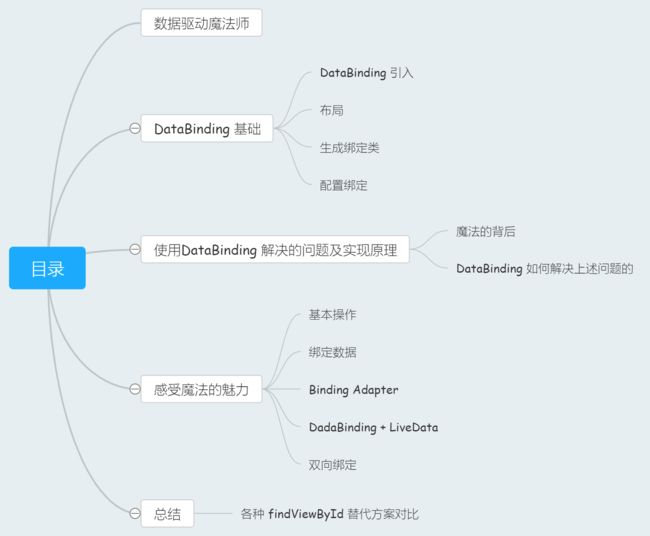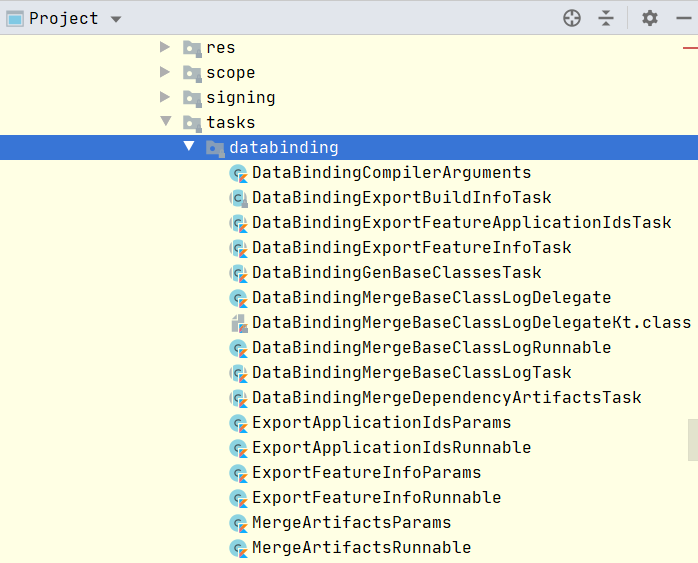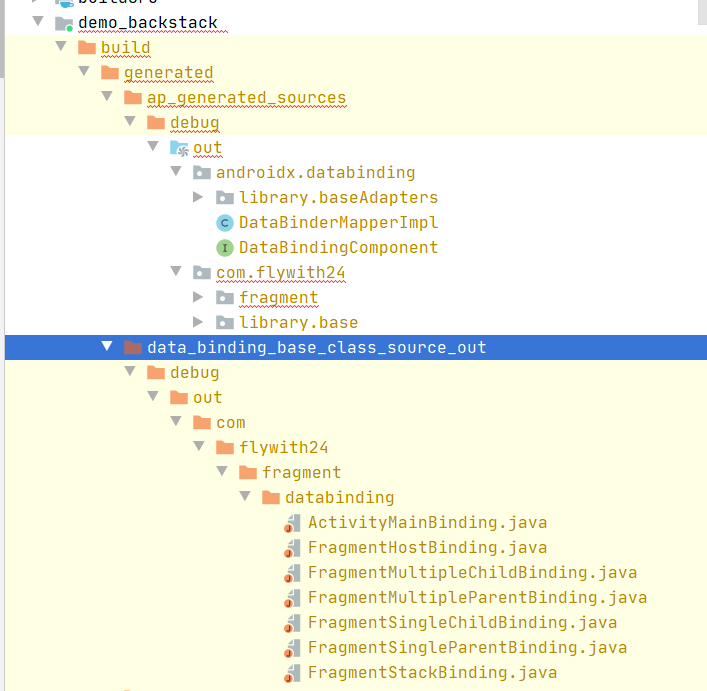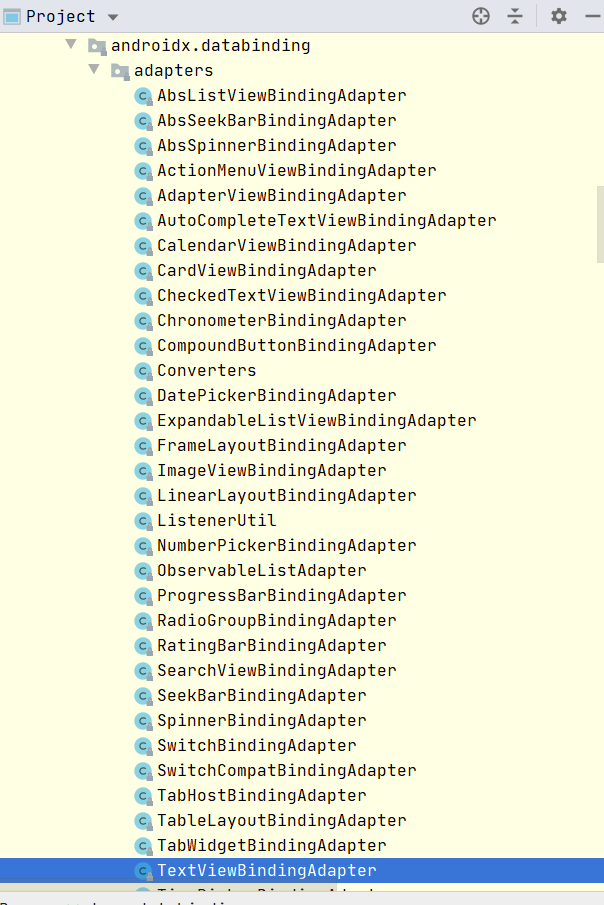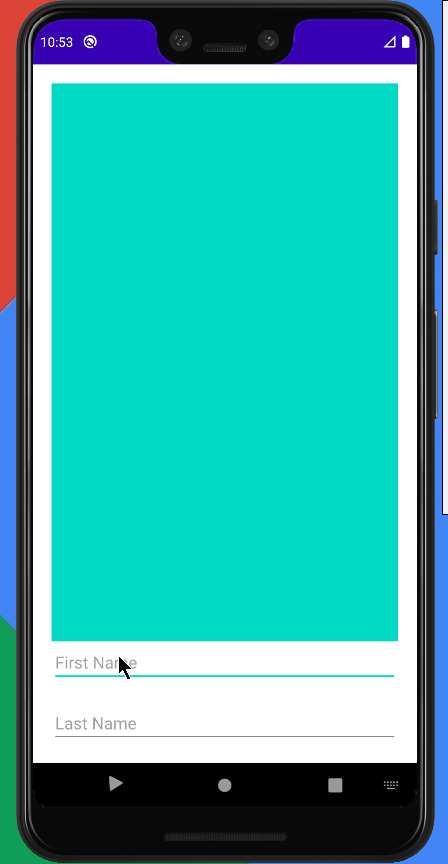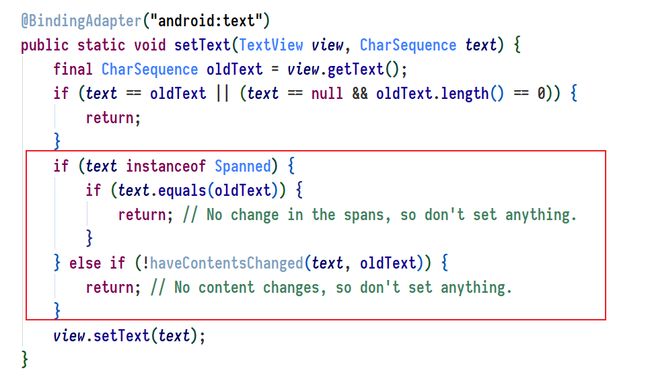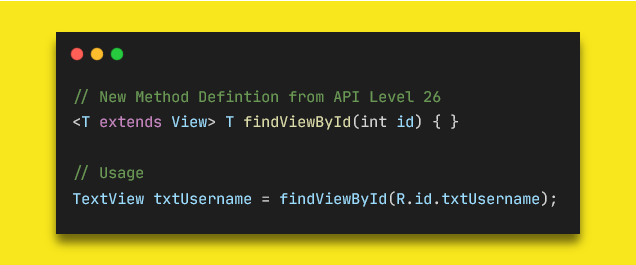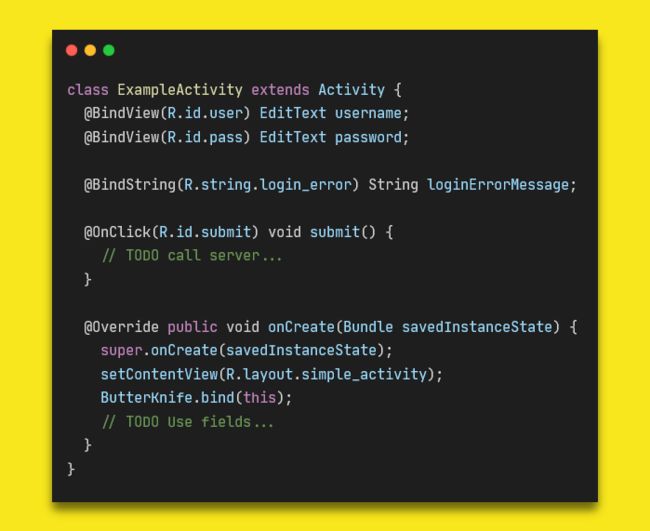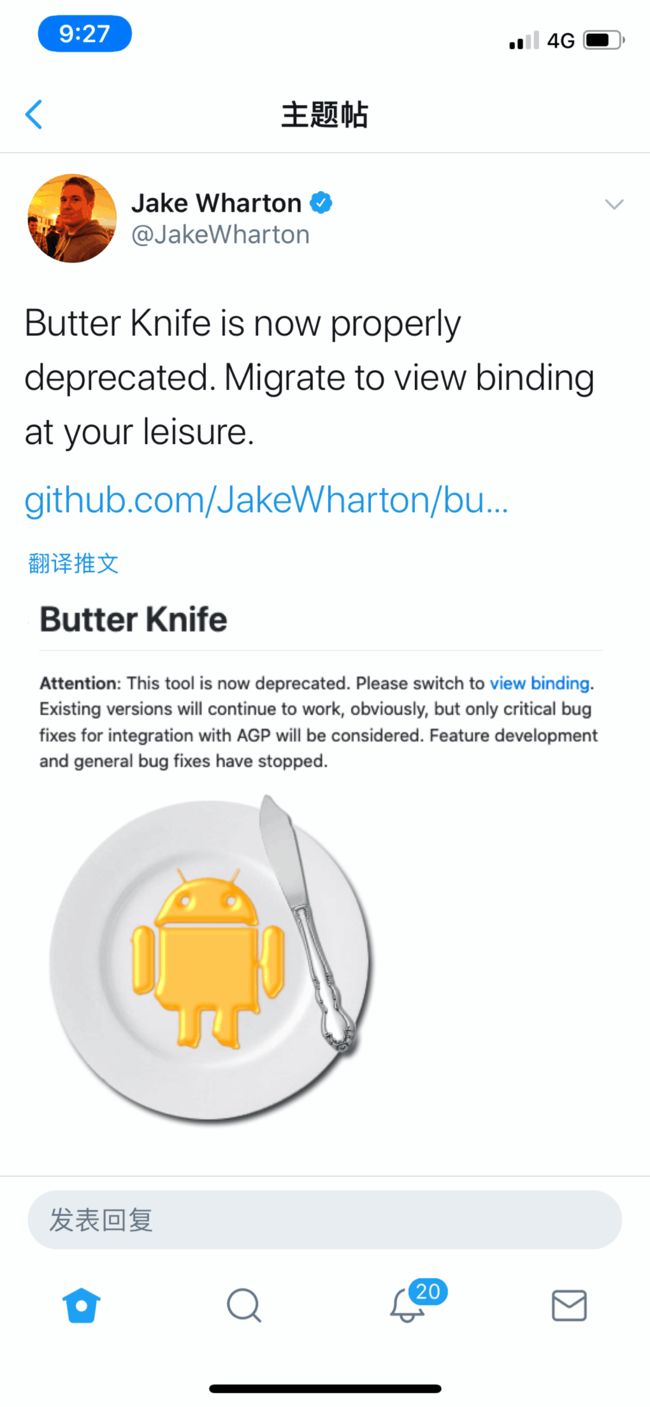系列文章
【背上Jetpack】Jetpack 主要组件的依赖及传递关系
【背上Jetpack】AdroidX下使用Activity和Fragment的变化
【背上Jetpack之Fragment】你真的会用Fragment吗?Fragment常见问题以及androidx下Fragment的使用新姿势
【背上Jetpack之Fragment】从源码角度看 Fragment 生命周期 AndroidX Fragment1.2.2源码分析
【背上Jetpack之OnBackPressedDispatcher】Fragment 返回栈预备篇
【背上Jetpack之Fragment】从源码的角度看Fragment 返回栈 附多返回栈demo
【背上Jetpack】绝不丢失的状态 androidx SaveState ViewModel-SaveState 分析
【背上Jetpack之ViewModel】即使您不使用MVVM也要了解ViewModel ——ViewModel 的职能边界
【背上Jetpack之Lifecycle】万物基于Lifecycle 默默无闻大作用
【背上Jetpack之LiveData】ViewModel 的左膀右臂 数据驱动真的香
前言
LiveData 篇 我们提到 Android 开发的主要工作内容是将数据转换为 UI ,同时我们也介绍了数据驱动 UI 的思想,使用 ViewModel + LiveData,可以安全地在订阅者的生命周期内分发正确的数据。但是 activity 和 fragment 充斥着大量的模板代码,铺天盖地的 findViewById,以及各种 set (根据数据设置 UI)。如果能够消灭掉这些模板代码就好了
他来了他来了,他欢快地走来了
然而,很多开发者对 DataBinding 存在偏见,「DataBinding 不是个好东西,在声明式编程中书写 UI 逻辑,既不可调试,也不便于察觉和追踪,万一出现问题就麻烦了。」
本文主要介绍 DataBinding 的解决的问题以及其背后的逻辑,带您对 DataBinding 有一个感性的认识。本文末尾会对各个 findViewById 的替代方案进行对比
DataBinding 的相关资源
- 官方文档
- codelab
- 官方示例
数据驱动魔法师
DataBinding 允许使用声明性格式而不是通过编程方式将布局中的 UI 组件与数据源绑定
// before
TextView textView = findViewById(R.id.sample_text);
textView.setText(viewModel.getUserName());
通过在布局文件中绑定组件,您可以删除 activity 中的许多设置 UI 调用,从而使它们更易于维护。 这也可以提高应用程序的性能,并有助于防止内存泄漏和空指针异常
如果仅替换 findViewById 而不需要数据的绑定,可以使用 ViewBinding,它使用起来更简单,性能也更好。
使用方法参见 [译]深入研究ViewBinding 在 include, merge, adapter, fragment, activity 中使用
基础
详细内容参见 官方文档 ,这里只简单介绍 DataBinding
DataBinding 引入
app build.gradle 中加入
android {
...
dataBinding {
enabled = true
}
}
// Android Studio 4.0
android {
...
buildFeatures {
dataBinding = true
}
}
必须在 app module 中声明,声明后其他子 module 可直接使用 DataBinding
使用 DataBinding 无需开发者手动引入库,android build gradle plugin 内部已经引入了
DataBinding 中使用了注解,因此在构建速度上比 ViewBinding 差些(不过功能这么强大要啥自行车)
布局
DataBinding 布局文件略有不同,它们以 layout 的根标记开始,后跟一个 data 元素和一个 view 根元素。 view 元素是您的根将位于非绑定布局文件中的元素。 以下代码显示了一个示例布局文件:
生成绑定类
DataBinding 会为每个在布局声明 layout 标签的 xml 布局文件生成一个绑定类。 默认情况下,类的名称基于布局文件的名称。 上面的布局文件名是 activity_main.xml,因此相应的生成类是 ActivityMainBinding。 此类包含从布局属性(例如,viewmodel 变量)到布局视图的所有绑定,并且知道如何为绑定表达式分配值
配置绑定
@Override
protected void onCreate(Bundle savedInstanceState) {
super.onCreate(savedInstanceState);
// before
// setContentView(R.layout.activity_main)
// after
val binding : ActivityMainBinding =
DataBindingUtil.setContentView(this, R.layout.activity_main)
}
使用DataBinding 解决的问题及实现原理
不知道你是否有这些烦恼:activity 和 fragment 中有着大量的模板代码,即使使用 ButterKnife 等工具写起代码来也很繁琐。而且 View id 与 View 的类型不匹配时,只有在运行期才能发现;旋转屏幕后如果新的布局中不存在之前 id 的 view ,可能还导致空指针异常;项目中使用各类 bus 通知 UI 刷新,但是有时 UI 的显示并不符合预期,而排查起来特别困难,因为数据源很多...
不要慌,DataBinding 可以解决以下问题
替换 findViewById ,减少模板代码
解决类型安全问题
解决空安全问题
保证了数据的一致性
魔法的背后
com.android.tools.build:gradle 插件中封装了 DataBinding 的魔法
查看 com.android.tools.build:gradle:3.6.2 的源码,找到 DataBinding 配置项的类 DataBindingOptions
// DataBindingOptions.java
@Override
public boolean isEnabled() {
// DataBinding 是否开启,对应上面在 build.gradle 中的配置
return enabled;
}
它的调用者很多,在 TaskManager 中的 createDataBindingTasksIfNecessary
// TaskManager
protected void createDataBindingTasksIfNecessary(@NonNull VariantScope scope) {
// 是否开启 DataBinding
boolean dataBindingEnabled = extension.getDataBinding().isEnabled();
boolean viewBindingEnabled = extension.getViewBinding().isEnabled();
if (!dataBindingEnabled && !viewBindingEnabled) {
// DataBinding 和 ViewBinding 均未开启则直接 return
return;
}
createDataBindingMergeBaseClassesTask(scope);
createDataBindingMergeArtifactsTask(scope);
//...
// 构建 DataBinding 相应绑定类
taskFactory.register(new DataBindingGenBaseClassesTask.CreationAction(scope));
}
// CreationAction
override fun handleProvider(taskProvider: TaskProvider) {
variantScope.artifacts.producesDir(
// DATA_BINDING_BASE_CLASS_SOURCE_OUT
InternalArtifactType.DATA_BINDING_BASE_CLASS_SOURCE_OUT,
BuildArtifactsHolder.OperationType.INITIAL,
taskProvider,
DataBindingGenBaseClassesTask::sourceOutFolder
)
}
可以看到生成 DataBinding 绑定类的 task 为 DataBindingGenBaseClassesTask,而InternalArtifactType.DATA_BINDING_BASE_CLASS_SOURCE_OUT 则对应着 build 目录生成的 DataBinding 类的
data_binding_base_class_source_out 目录
这里可以简单看一下,感兴趣的小伙伴可以自己查看源码
DataBinding 如何解决上述问题的
我们可以查看 DataBinding 生成的绑定类
public final class FragmentSingleChildBinding implements ViewBinding {
// NonNull 注解标记
// 如果存在不同配置的不同布局文件(如横竖屏)且该控件不是存在于所有布局,该处使用 Nullable注解标记
@NonNull
public final MaterialButton button;
// 省略...
@NonNull
public static FragmentSingleChildBinding bind(@NonNull View rootView) {
String missingId;
missingId: {
//其内部也是使用 findViewById
MaterialButton button = rootView.findViewById(R.id.button);
if (button == null) {
missingId = "button";
break missingId;
}
return new FragmentSingleChildBinding((MaterialButton) rootView, button);
}
throw new NullPointerException("Missing required view with ID: ".concat(missingId));
}
}
Binding 类内部的也是使用 findViewById ,因此 DataBinding 可以代替 findViewById ,并且减少模板代码
View 控件变量类型是固定的,因此不会出现类型安全问题
View 控件变量由空/非空注解修饰,(如果为 Nullable java 中会有 lint 警告,而 kotlin 直接调用时无法通过编译的)因此 不会出现空安全问题
通过声明式的配置,UI 完全来自唯一可信的数据源配置,保证了数据的一致性
注意:以上分析同样适用于 ViewBinding
感受魔法的魅力
这里简单展示一下 DataBinding 的「魔法」
基本操作
public class MainActivity extends AppCompatActivity {
@Override
protected void onCreate(Bundle savedInstanceState) {
super.onCreate(savedInstanceState);
// Before Data Binding
//setContentView(R.layout.activity_main);
//TextView firstName = (TextView) findViewById(R.id.firstName);
//TextView lastName = (TextView) findViewById(R.id.lastName);
//firstName.setText("xxx");
//lastName.setText("xxx");
// After Data Binding
ActivityMainBinding binding = DataBindingUtil.setContentView(this, R.layout.activity_main);
binding.firstName.setText("xxx");
binding.lastName.setText("xxx");
}
}
上面展示了 DataBinding 的基础操作(单纯的替换 findViewById),如果仅使用 DataBinding 这部分功能,可以考虑使用 ViewBinding
绑定数据
在之前的布局的基础上绑定数据
public class MainActivity extends AppCompatActivity {
@Override
protected void onCreate(Bundle savedInstanceState) {
super.onCreate(savedInstanceState);
ActivityMainBinding binding = DataBindingUtil.setContentView(this, R.layout.activity_main);
binding.user = new User("xxx","xxx");
}
}
这种方式也可以用在 recyclerview adapter 中,adapter 中的代码大大减少
Binding Adapter
您可能会好奇配置 android:text="@{user.firstName} 后内部发生了什么
DataBinding 中使用 Binding Adapter 来处理,它主要处理「属性」和「事件」,前者如 setText() ,后者如 setOnClickListener()。上面的 android:text 实际上调用的是下面的方法
DataBinding 中提供了很多 Binding Adapter
如果官方提供的 Binding Adapter 不满足您的需求,您还可以自定义 Binding Adapter
@BindingAdapter({"imageUrl", "error"})
public static void loadImage(ImageView view, String url, Drawable error) {
Glide.with(view).load(url).error(error).into(view);
}
DadaBinding + LiveData
要将 LiveData 与 DataBinding 一起使用,需要指定生命周期所有者来定义 LiveData 对象的范围
class ViewModelActivity extends AppCompatActivity {
@Override
protected void onCreate(Bundle savedInstanceState) {
UserBinding binding = DataBindingUtil.setContentView(this, R.layout.user);
binding.setLifecycleOwner(this);
}
}
双向绑定
使用单向 DataBinding,可以在属性上设置一个值,并设置一个对该属性的更改做出反应的监听器:
使用双向绑定可以简化该过程
使用 @={} 接收对该属性的数据更改,并同时监听用户更新(注意,这里有 = )
那么究竟什么是双向绑定呢?
所谓的「数据驱动」就是数据驱动视图的变化,而 DataBinding 的单向绑定就是如此。反过来讲,有些时候我们需要视图来驱动数据的变化(例如当我们在 EditText 上输入了文字,我们希望对应的 ViewModel 的 LiveData 的值能够及时响应该变化)
如图,绿色部分为独立的 fragment ,内部存在两个 TextView,用于显示外部 fragment EditText 输入的文字
如果实现上述功能,传统做法可能是使用 activity 级别的 ViewModel 进行两个 fragment 之间的通信,通过监听 EditText 文字的变化改变 ViewModel 中 LiveData 的值,并在绿色 fragment 中观察 LiveData 并显示到 TextView 中
class NormalViewModel : ViewModel() {
val firstName = MutableLiveData()
val lastName = MutableLiveData()
}
class NormalDetailFragment : Fragment(R.layout.fragment_normal_detail) {
private val mViewModel by activityViewModels()
override fun onViewCreated(view: View, savedInstanceState: Bundle?) {
mViewModel.firstName.observe(viewLifecycleOwner) {
tvFirstName.text = it
}
mViewModel.lastName.observe(viewLifecycleOwner) {
tvLastName.text = it
}
}
}
class NormalFragment : Fragment(R.layout.fragment_normal) {
private val mViewModel by activityViewModels()
override fun onViewCreated(view: View, savedInstanceState: Bundle?) {
etFirstName.addTextChangedListener {
mViewModel.firstName.value = it.toString()
}
etLastName.addTextChangedListener {
mViewModel.lastName.value = it.toString()
}
}
}
得益于 kotlin ,上面的代码以及很简洁了,如果使用 java 代码片段只会更长。
不过使用 DataBinding,还可以更简洁
只需配置好双向绑定(EditText 驱动 ViewModel 的 LiveData 的值变化,ViewModel 再驱动 TextView 显示数据),并在 fragment 通过固定的模板代码设置好 ViewModel 即可
这里的魔法还是来自 Binding Adapter
// TextViewBindingAdapter.java
@BindingAdapter(value = {"android:beforeTextChanged", "android:onTextChanged",
"android:afterTextChanged", "android:textAttrChanged"}, requireAll = false)
public static void setTextWatcher(TextView view, final BeforeTextChanged before,
final OnTextChanged on, final AfterTextChanged after,
final InverseBindingListener textAttrChanged) {
final TextWatcher newValue;
if (before == null && after == null && on == null && textAttrChanged == null) {
newValue = null;
} else {
newValue = new TextWatcher() {
@Override
public void beforeTextChanged(CharSequence s, int start, int count, int after) {
if (before != null) {
before.beforeTextChanged(s, start, count, after);
}
}
@Override
public void onTextChanged(CharSequence s, int start, int before, int count) {
if (on != null) {
on.onTextChanged(s, start, before, count);
}
if (textAttrChanged != null) {
//通知发生变化
textAttrChanged.onChange();
}
}
@Override
public void afterTextChanged(Editable s) {
if (after != null) {
after.afterTextChanged(s);
}
}
};
}
final TextWatcher oldValue = ListenerUtil.trackListener(view, newValue, R.id.textWatcher);
if (oldValue != null) {
view.removeTextChangedListener(oldValue);
}
if (newValue != null) {
view.addTextChangedListener(newValue);
}
}
这里使用 InverseBindingListener (调用 textAttrChanged.onChange())来通知 LiveData 数据发生变化
而变化后的值 通过 @InverseBindingAdapter 注解标记的方法处理,这里的 event 与上面的标记匹配(android:textAttrChanged)
// TextViewBindingAdapter.java
@InverseBindingAdapter(attribute = "android:text", event = "android:textAttrChanged")
public static String getTextString(TextView view) {
return view.getText().toString();
}
view 层变化通知数据变化,数据变化再通知 view 层变化,仿佛是个套娃
因此避免这种死循环十分重要,setText 方法判断了新旧值是否相等来避免死循环
总结
DataBinding 主要提供两部分功能
- 替换 findViewById ,如果只用这部分功能可以使用 ViewBinding
- 进行 data 和 UI 的绑定,使用「数据驱动」的思想解决了视图的一致性问题
各种 findViewById 替代方案对比
- findViewById
- Butterknife
- Kotlin Synthetics
- Data Binding
- View Binding
findViewById
findViewById 有两个问题
- 当不能在 Activity/Fragment/ViewGroup 中定位到指定 id 的 View,会在运行期间崩溃,即非空安全
- 如果某个 view 为 TextView 类型,而在使用中将其指定为其他类型不会在编译器报错,即非类型安全
在 compileSdk 的 API 级别 26 中,对该方法的定义稍作更改以消除强制类型转换问题
现在,开发人员无需在代码中手动转换 view 类型。 如果您引用 id 指向类型 TextView 的 View 并将其指定为 Button,则 Android SDK 会尝试查找具有提供的 id 的 Button,并且它将返回 Null,因为它将无法找到它
但是在 Kotlin 中,您仍然需要提供诸如 findViewById
Butterknife
Butterknife 是 Jake Wharton 大神写的替代 findViewById 的库,该库使用注解处理并生成 findViewById 代码
它具有与 findViewById 几乎相似的问题。 但是,它在运行时添加了null 安全检查以避免 NullPointerException
由于 DataBinding 和 ViewBinding 的出现,沃神已经宣布弃用该库
Kotlin Synthetics
Kotlin 引入的最大功能之一是 Kotlin 扩展方法。 在它的帮助下,Kotlin Synthetics 诞生了。 Kotlin Synthetics 通过自动生成的 Kotlin 扩展方法,使开发人员可以从 xml 布局直接访问其内部的 view
Kotlin Synthetics 第一次调用 findViewById 方法,然后默认情况下将 view 实例缓存在 HashMap 中。 可以通过Gradle 设置将此缓存配置更改为 SparseArray 或不缓存
总体而言,Kotlin Synthetics 是一种很好的选择,因为它类型安全,并且通过 Kotlin 的 ?进行空检查。 它不需要开发人员的额外代码。 但这仅适用于 Kotlin 项目
但是,在使用 Kotlin Synthetics 时遇到了一个小问题。 例如,如果将内容视图设置为布局,然后使用仅存在于其他布局中的 id ,则 IDE 可让您自动完成并添加新的 import 语句。 除非您专门检查以确保其 import 语句仅导入正确的 view,否则没有安全的方法来验证这不会导致运行时问题
DataBinding
DataBinding 在功能上比其他方法优越得多,因为它不仅为您提供类型安全和空安全的 view 引用,而且还允许您直接在 xml 布局内使用数据驱动视图变化
ViewBinding
最近在 Android Studio 3.6 中引入的 ViewBinding 是 DataBinding 库的子集。 由于不需要注解处理,因此可以缩短构建时间。详细的使用可以参见 这篇文章
| findViewById | Butterknife | Kotlin Synthetics | DataBinding | ViewBinding | |
|---|---|---|---|---|---|
| 一直空安全 | ❌ | 部分 | 部分 | ✔️ | ✔️ |
| 类型安全 | ❌ | ❌ | ✔️ | ✔️ | ✔️ |
| 样板代码 | 多 | 少 | 少 | 中等 | 少 |
| 构建时间 | ✔️ | ❌ | ✔️ | ❌ | ✔️ |
| 支持语音 | java/kotlin | java/kotlin | kotlin | java/kotlin | java/kotlin |
关于我
我是 Fly_with24
- 掘金
- Github
